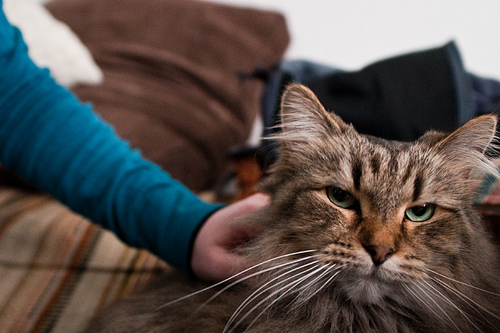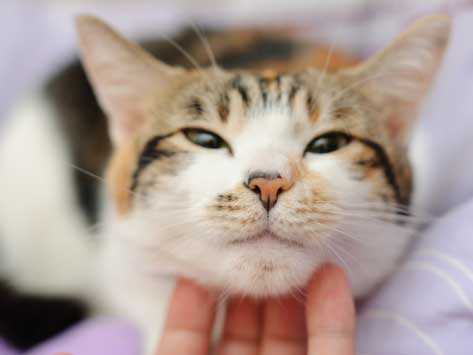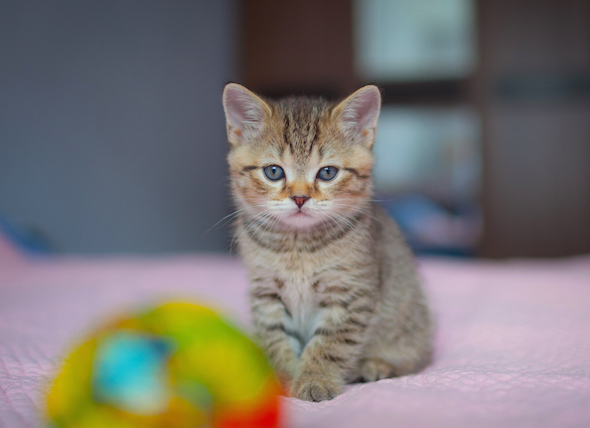

By Shara Rutberg
Most cats will naturally seek out a sandy, granular place to eliminate. There are things cat parents can do, however, to encourage proper litter box use throughout a cat’s life. Find tips on how to litter train your cat, as well as the best type of litter box to get, below.
Most people buy litter boxes that are too small for their cats, said Sally J. Foote, DVM and International Association of Animal Behavior Consultants (IAABC) certified feline behavior consultant. Your cat’s litter box should be approximately one and a half times its length. Waste should be scooped out of your cat’s box every day and the box should be thoroughly cleaned once a month, said certified cat behavior consultant Marilyn Krieger.
Your cat’s preference for eliminating in an area that is clean stems from the fact that in the wild, a cat is both predator and prey. “The smell of excrement attracts predators,” Krieger said, making your cat’s tidy habits a natural instinct to avoid being caught. For the same reason, many cats prefer to use an uncovered box.
“In nature, cats don’t want to get caught by a predator inside an enclosed area,” said IAABC certified cat behavior consultant Mieshelle Nagelschneider. Many of her clients mistakenly believe their cats prefer the privacy of a cover. “But the opposite is true,” she says. “Cats don’t want to feel trapped.”
Whether or not your cat prefers a restroom with or without a roof comes down to your kitty’s personal preference, said Foote, who has found that some cats prefer an open space to eliminate, while others prefer an enclosed space. She suggests giving your cat a choice in the beginning to see what they prefer.
If you’re bringing a new cat into your home, the best choice of litter is the kind they used in their previous situation, Foote said, adding that keeping the litter clean is more important than what specific type you use. According to the Humane Society, research has shown that most cats prefer fine-grained litters, presumably because they have a softer feel. Many cats, however, have their own individual preference when it comes to scented or unscented and clumping or non-clumping litters. Often, cats won’t eliminate in a box that has corn or wheat-based litter because it smells like food, which a cat won’t want to eliminate on, Nagelschneider said.
How frequently you replace the litter depends on how many cats and boxes you have and what type of litter you use. The Humane Society recommends replacing clay litter twice a week. If you do scoop the box daily, however, you might only need to change clumping litter every two to three weeks.
Litter box placement can be a critical factor in encouraging your cat to use the box. Experts recommend having at least one box for each cat in your household per level of your house (i.e. two cats in a two story home should have a minimum of four litter boxes) and not stashing them in a closet. Again, this is because cats don’t like to feel cornered or trapped during toileting, Foote said. You’ll also want to make it easy for your cat to get to the box or boxes.
“Don’t make them have to go down the stairs, through the playroom, through the kitty door, into the utility room,” Nagelschneider said. “Cat’s don’t want to go any farther than we do to reach the bathroom.”
They’ll also need some sort of light to see and find their boxes, so if there’s no ambient light in the place where you keep the litter box, try using a nightlight, Nagelschneider said.
Luckily for pet owners, it’s a kitten’s mom who does the important work of litter training her offspring. Kittens begin to model their own elimination habits on their mother’s litter box behavior from around two or three weeks of age, Foote said. However, kittens that have been raised without a mother to learn from may require help figuring out the litter box.
To help those kittens, use a kitten-sized litter box (Foote recommends a 13 by 9 inch pan) then graduate to a more commercial-sized box. Keep the kitten, his or her food and water, and the box in a small room with no rugs or carpet. Each time the kitten uses the box, give him or her a treat and clean the box.
As cats age, they may have a tougher time making it to the litter box. To help, provide your cat with more litter boxes throughout the home so that he or she doesn’t have to travel too far to reach one. Age-related issues like arthritis can also make it tough for cats to step up and into litter boxes with tall sides, said Foote, so look for a box with a lip that’s just two to three inches high. If your cat begins eliminating outside of the litter box, speak with your veterinarian as soon as possible to rule out any underlying medical issues that may be causing the inappropriate urination.
Being aware of any physical limitations that may develop as your cat ages, knowing your cat’s unique preferences for litter and litter boxes and placing litter boxes with cats’ natural instincts in mind will help ensure litter box success throughout their lifetime.
 10 Questions Every Pet Food Manufacturer Should Answer
By Vanessa Voltolina
Feel confident that your pet
10 Questions Every Pet Food Manufacturer Should Answer
By Vanessa Voltolina
Feel confident that your pet
 Top 5 Tips for a Healthy Cat
Keeping your cat healthy, groomed, and wel
Top 5 Tips for a Healthy Cat
Keeping your cat healthy, groomed, and wel
 Should I Give My Cat Supplements?
By Ashley Gallagher, DVM
Vitamins and supplements
Should I Give My Cat Supplements?
By Ashley Gallagher, DVM
Vitamins and supplements
 How Do Cats Show Love? Let Us Count Six Ways
By Cheryl Lock
They’re known for
How Do Cats Show Love? Let Us Count Six Ways
By Cheryl Lock
They’re known for
 Cat Facts: How Long Are Cats In Heat
By Helen Anne Travis
With millio
Cat Facts: How Long Are Cats In Heat
By Helen Anne Travis
With millio
Copyright © 2005-2016 Pet Information All Rights Reserved
Contact us: www162date@outlook.com